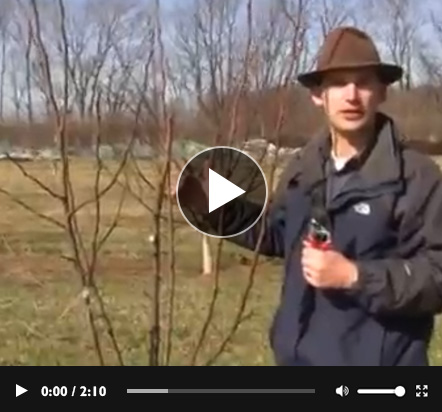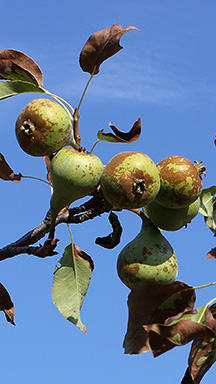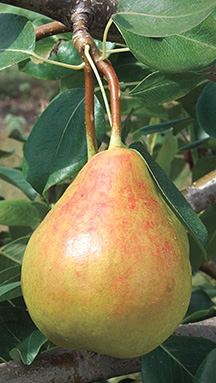Pear trees are part and parcel of our American heritage
Pears, like apple trees, have been grown in the United States since Europeans started settling North America. In fact, what is thought to be the oldest living cultivated fruit tree in the country is still alive and well and nearly 400 years old. This tree was planted just after settlers arrived at Plymouth Rock.
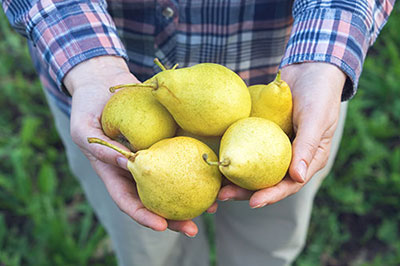
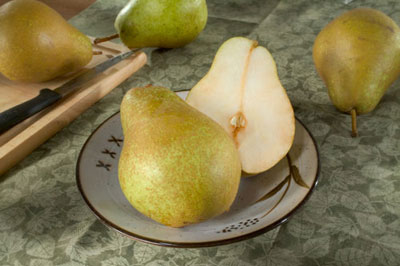
What types of pears can I grow?
European pear
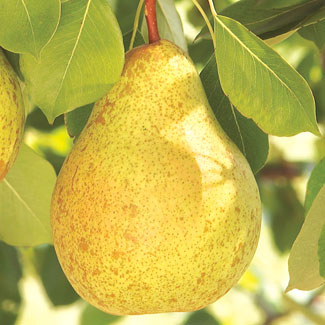
Asian pear
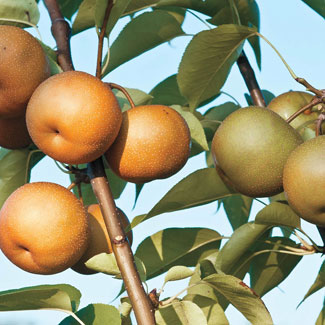
Our varieties of European pears are rich in flavor, but if you haven't tried an Asian pear, you're in for a real treat!
If the only homegrown pear variety you have ever known is that old, rock-hard, gritty textured Kieffer pear growing in your neighbor's yard, you are in for a treat. The pear world has much more to offer.
There are two main types of pear trees for sale: European and Asian pears.
European pears (Pyrus communis) are the classic pear-shaped pears. They are richly flavored, have juicy white flesh and a smooth, firm texture. Bartlett and Bosc pears are good examples and are often seen in grocery stores. But the home gardener has more pear varieties to choose from than those sold by grocers. Gurney's offers more than 12 varieties, including Honeysweet and Ambrosia, which are particularly excellent choices.
Most European pears are picked slightly under ripe and stored in the refrigerator for two to three weeks. Following this cool storage period, they can be placed at room temperature to finish ripening. This process helps create the rich flavor and smooth, melting texture.
Asian pears (Pyrus pyrifolia) are quite different. Their shape is round and their flesh is crisp, juicy and extremely sweet. Asian pears have more of a crunch like apples. Some people refer to them as the apple pear. Asian pears can be left to ripen on the tree.
Two of Gurney's most popular Asian pear varieties are Chojuro and Drippin' Honey. Chojuro is a classic Asian pear with a rich, butterscotch flavor, and Drippin' Honey is a juicy, honey-sweet pear with a delightful crunch.
We have a breeding breakthrough!
I mentioned two main types of pears. Well, there is a third, very unusual type of pear: Crisp 'n Sweet. It's a cross between an Asian pear and a European pear, and it combines the best fresh-eating qualities of each type. Crisp 'n Sweet has the sweet, rich flavor of a European pear and the crispy texture of an Asian pear. Plus, it can be
picked ripe.

Crisp 'n Sweet is not only larger than your typical European pear, it combines the best traits of both European and Asian pears.
Does size matter when choosing a rootstock?
If you buy a bareroot or potted pear tree, the variety you select will be grafted or budded onto a rootstock. The rootstock we use determines mature tree height. We offer pear trees on two different rootstocks: standard and semi-dwarf. Our rootstocks have strong resistance to several common diseases, including fire blight and pear decline. These trees will produce for many decades if properly maintained.
Standard rootstock produces full-sized trees that can reach 20-25 feet when mature. They are fire blight resistant and well anchored with vigorous root systems. When the trees reach maturity, fruit production is heavy.
Semi-dwarf rootstock produces medium-sized trees that reach 12-15 feet at maturity. This rootstock is resistant to many pear diseases and insects. Plus, the trees bear fruit at an earlier age than standard trees.
We do not offer a dwarf pear tree. The rootstocks currently available to produce a dwarf tree have too many flaws for us to consider using them. We want our customers to have a good growing experience, and these dwarf pear trees may present too many problems. We continue to trial new dwarfing rootstock with the hopes of finding one perfect for our customers.

Are pear trees easy to grow?
Pears are one of the easiest fruit trees to grow. You are halfway there just by giving them full sun, average soil, and water during extended dry spells. See our planting video. Prune pear trees to create a central leader framework and remove vigorous water sprouts. This helps ensure that remaining branches receive the sunlight needed for fruit development. Also, a few well-timed sprays will help keep the tree in your yard or garden free of pest and diseases.
Fire blight is the main disease to watch for when growing pear trees. It causes leaves to shrivel and turn black during the summer. Another sign of the disease is the appearance of new twigs that wither and die as they curl back into the shape of a shepherd's crook. Fire blight can also affect blossoms and fruit. If left untreated, it can kill a tree and spread to others. You can avoid fire blight by choosing a resistant variety. Are you a big fan of Bartlett pears? Unfortunately, Bartlett is susceptible to fire blight. The good news is you can grow Moonglow pear—it has the same delicious qualities of Bartlett without the susceptibility to fire blight.
Do I need a pair of pears to cross-pollinate?
Some pears do not need to be cross-pollinated to produce fruit, but most do. Even the self-fruitful varieties fruit better and heavier when they are cross-pollinated with a different variety. Honeysweet is one variety Gurney's offers that produces a full crop without the aid of another variety. To help pick the perfect pollinating partners, see our pollination chart.
Pear trees are an investment in the future
Buying pear trees is one of the best investments you can make. These cold-hardy, nearly disease-free trees will reward you and generations to come with picturesque trees, beautiful blossoms and delicious fruit.





 Gardens Alive! & Supplies
Gardens Alive! & Supplies




